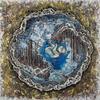Inaugural Visual Art Program at the Kennedy Center's New REACH Expansion to Feature Glenstone Museum Loans
- WASHINGTON, DC
- /
- September 05, 2019
The John F. Kennedy Center for the Performing Arts has announced its inaugural presentation of visual art to be featured at the REACH, the Center’s 21st-century expansion project. Ten works in a rich diversity of media will be on display at the facility upon opening, including six pieces on loan from Glenstone Museum in Potomac, Maryland; sculptures by Joel Shapiro, Deborah Butterfield, and Roy Lichtenstein; and a wall hanging by Sam Gilliam. All works will be on view for the public beginning September 7, 2019.
Artists represented also include Thomas Demand, Glenn Lignon, Fred Tomaselli, Mike Kelley, and Faith Ringgold. In addition to the artworks secured through gift and loan, the REACH will also host several pieces by citizen artists including Michelle Ortiz, a 2019-2020 Kennedy Center Citizen Artist Fellow, and brothers Steven and William Ladd, who will be leading a “Scrollathon” workshop during the last week of the Opening Festival.
Emily Wei Rales, Director and Co-founder of Glenstone Museum, noted, “The Glenstone works on loan span the period from JFK’s presidency to 2018 while sampling the diversity of backgrounds and viewpoints that is the essence of our democracy. We hope they will add to the magnificent new experience that the Kennedy Center offers the public.”
The loans from Glenstone for the opening of the REACH mark the beginning of a loan program between The Kennedy Center and Glenstone, with the potential to loan dozens of works in the coming years. The ten works on display—a half-century of visual art that includes paintings, sculptures, photography, and mixed media assemblage—reflect a wide variety of expression, from pure aesthetic abstraction to direct social engagement.
One loan is by artist Glenn Ligon who uses texts by favorite authors to reflect on key fault lines in society, such as race and sexuality. This work is a single word of text, but one rich with myriad meanings for different groups: “America.” Spelled in all capital letters, in glowing red neon, and upside down, it conveys a sign of distress. Ligon’s works often address the aftershocks of slavery in American life and the continuing struggle for social justice. He says, “We always imagine that slavery is something in the past and that we as a society have gotten over it… But if you think about slavery as there when our laws and institutions are being created—when our Declaration of Independence is being written, when our courts are being formed—it is this moral dilemma at the core of our democracy and we still feel its effects.”
Also on view, Kennedy Center Chairman David M. Rubenstein has lent one of the few surviving William J. Stone copies of the Declaration of Independence, engraved on vellum in 1823.
“As we prepare to open the doors of the REACH for the first time—with an action-packed 16-day celebration of the performing arts—we invite visitors to pause and consider this collection of visual works that augments our usual range of artistic programming,” remarks Kennedy Center President Deborah F. Rutter. “We are incredibly grateful to all of the artists and galleries—especially to Glenstone—whose works will grace the new campus, sharing a legacy of visual art that stretches from the time of President John F. Kennedy to today.”

![Arthur Pinajian [1914-1999] Untitled, No.4386, 1958 Arthur Pinajian [1914-1999] Untitled, No.4386, 1958](/images/c/b7/f0/Mar14_Arthur_Pinajian_1914-1999__Untitled_No_100x100_c.jpg)













